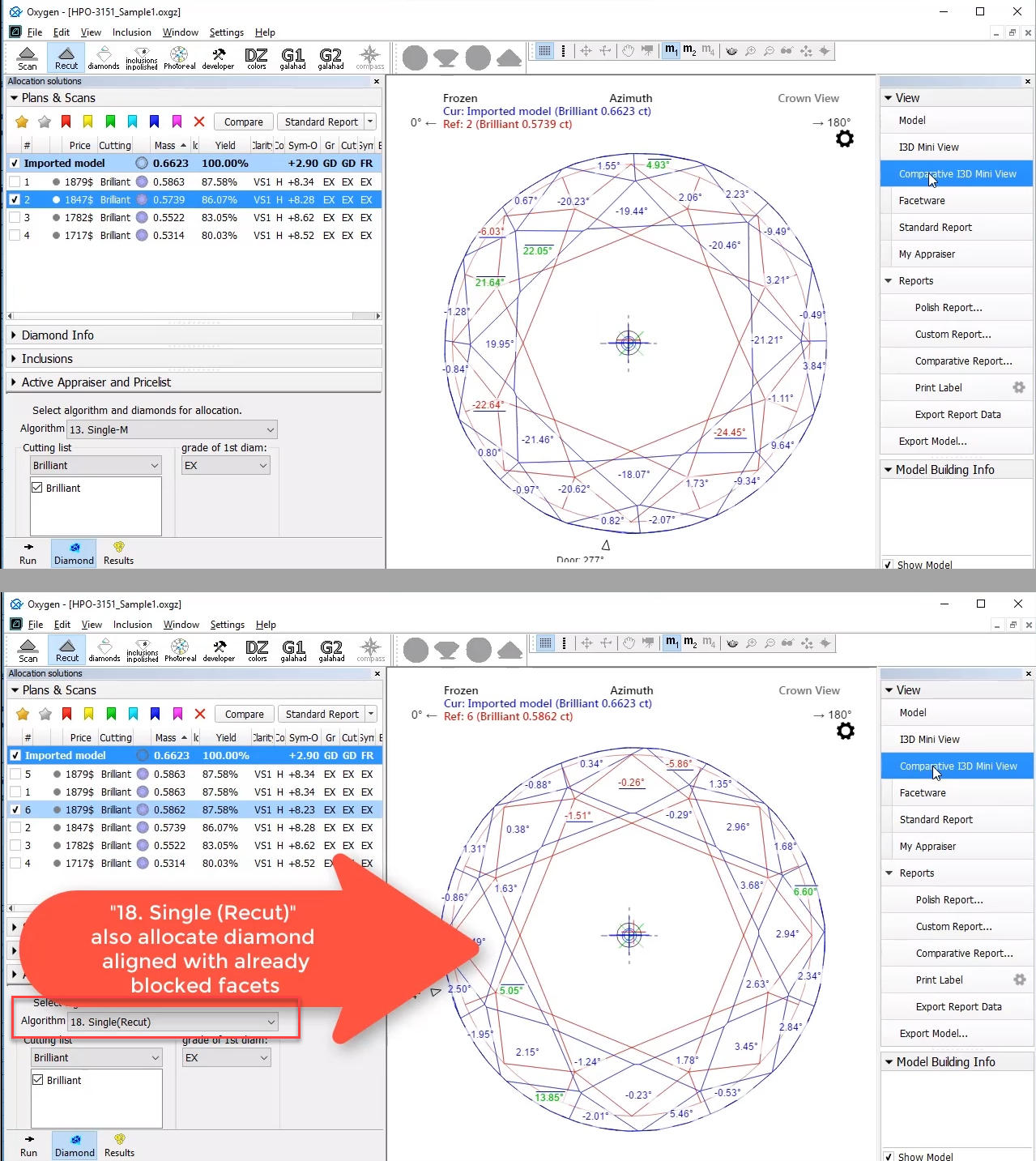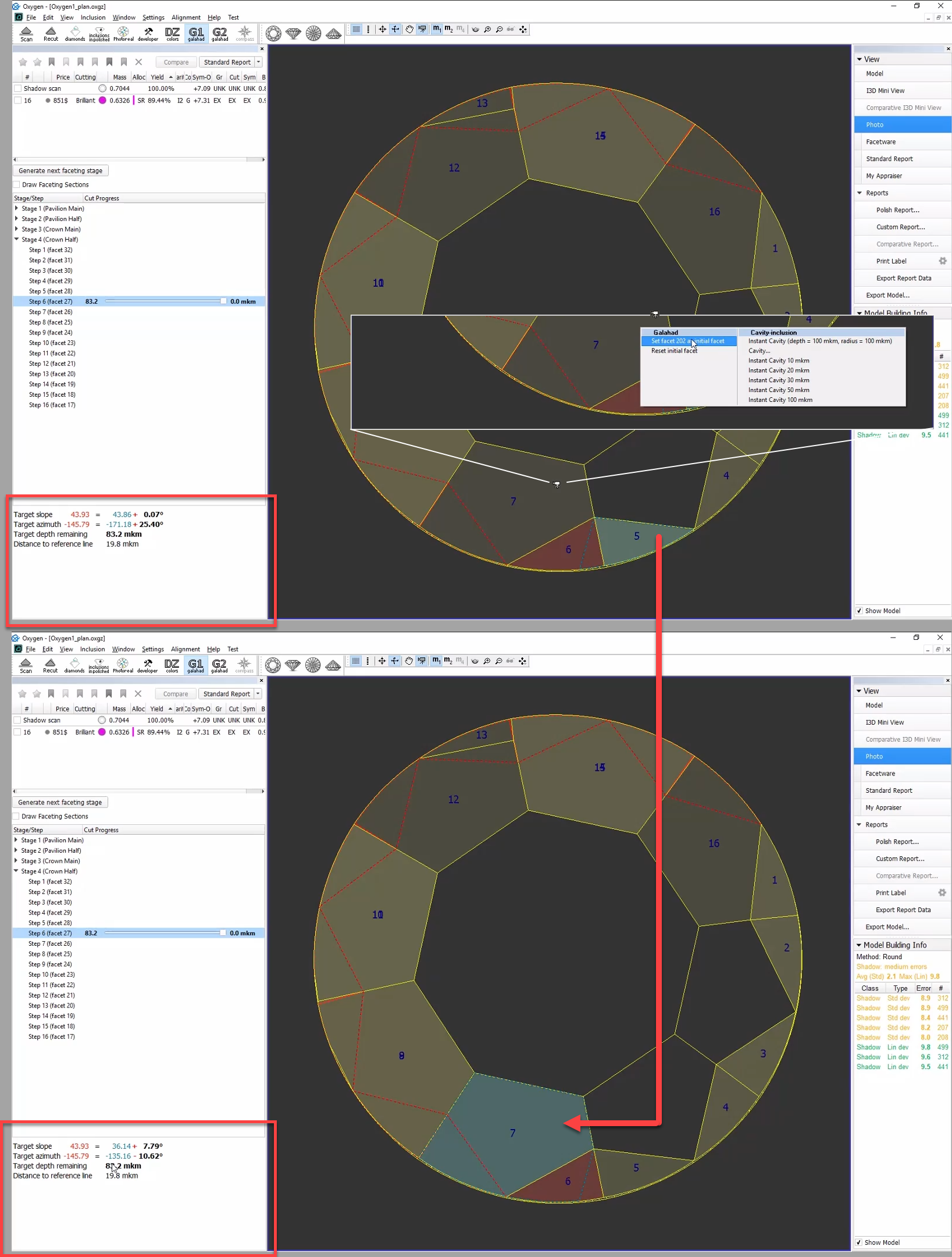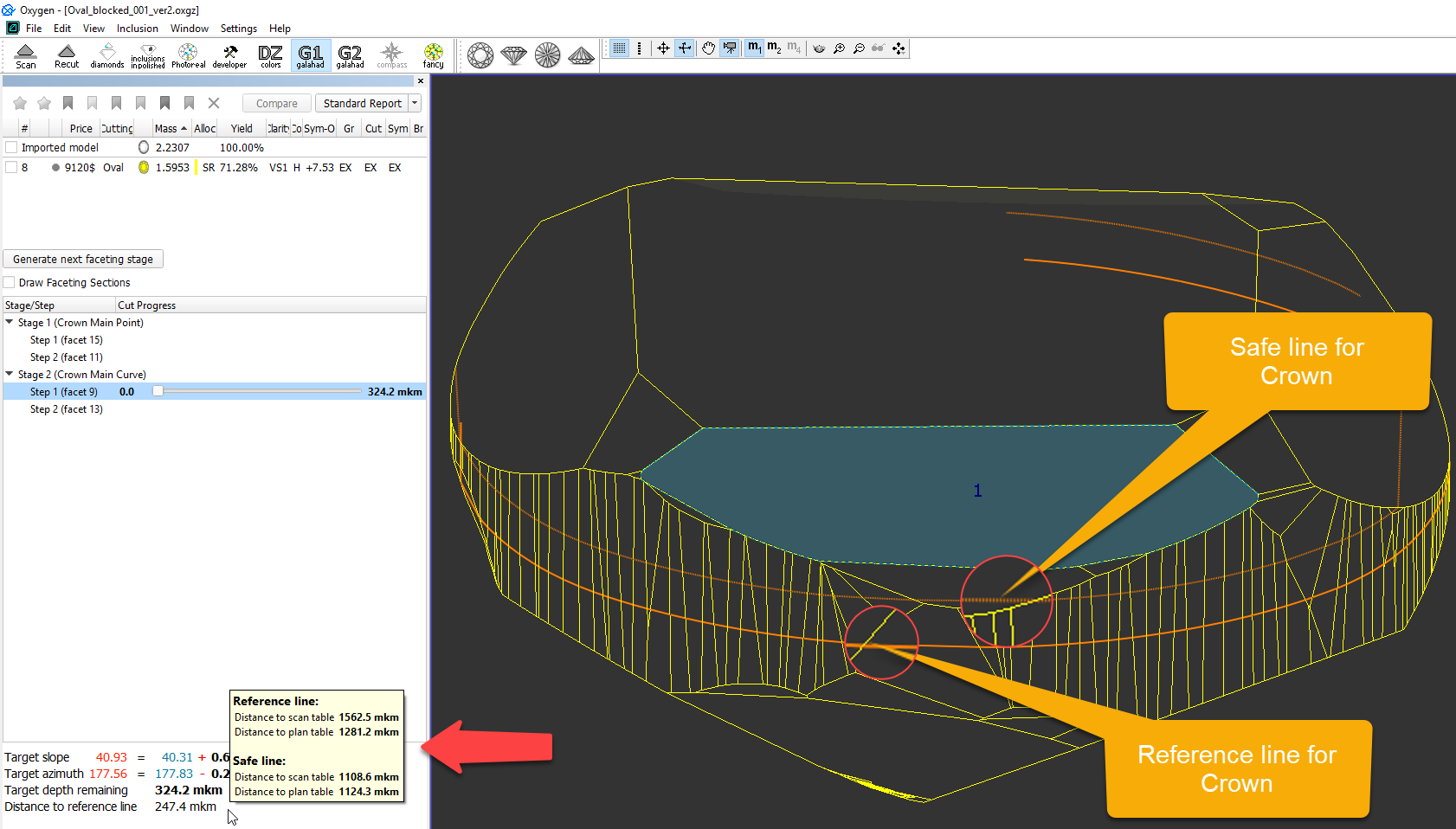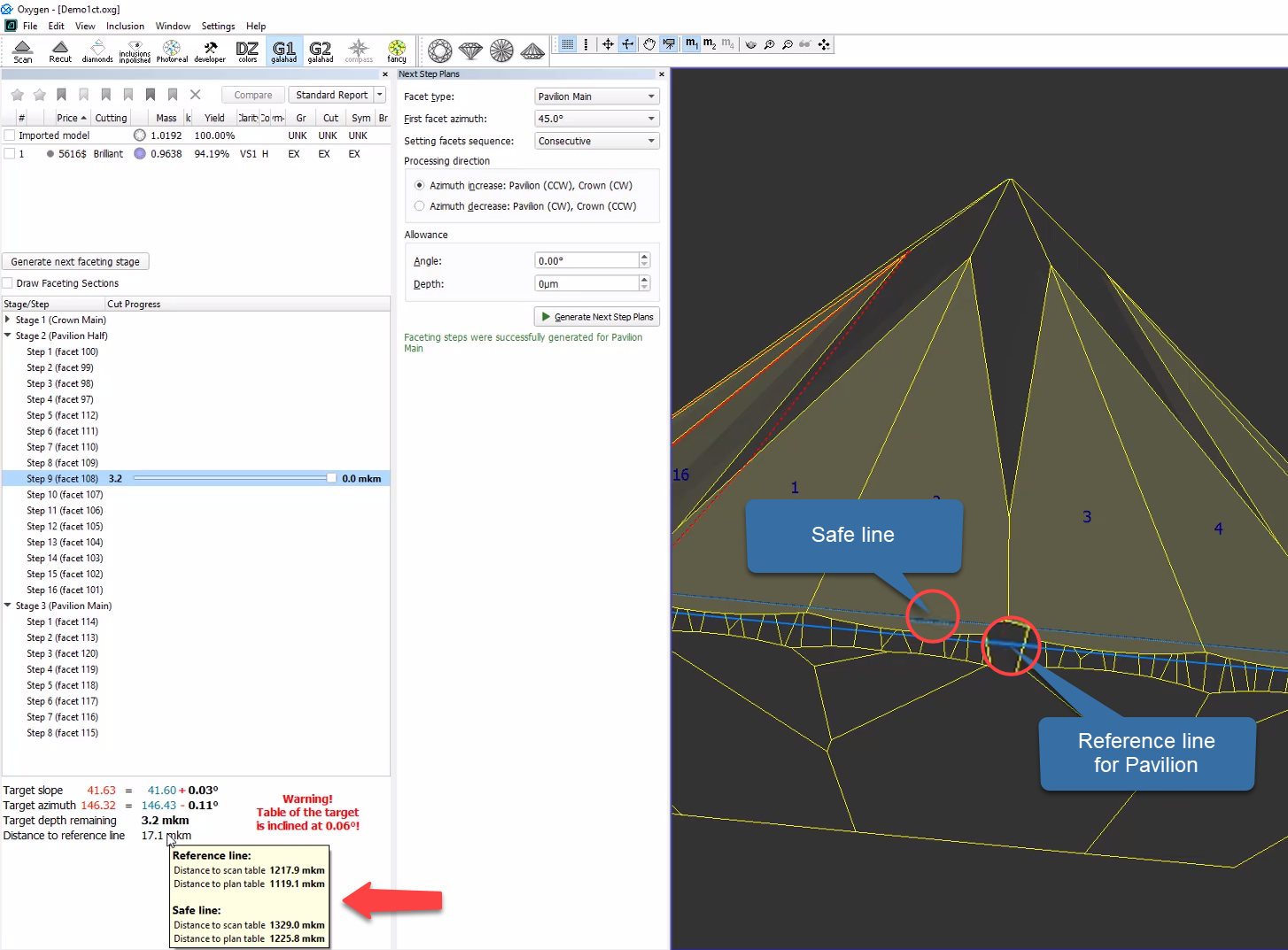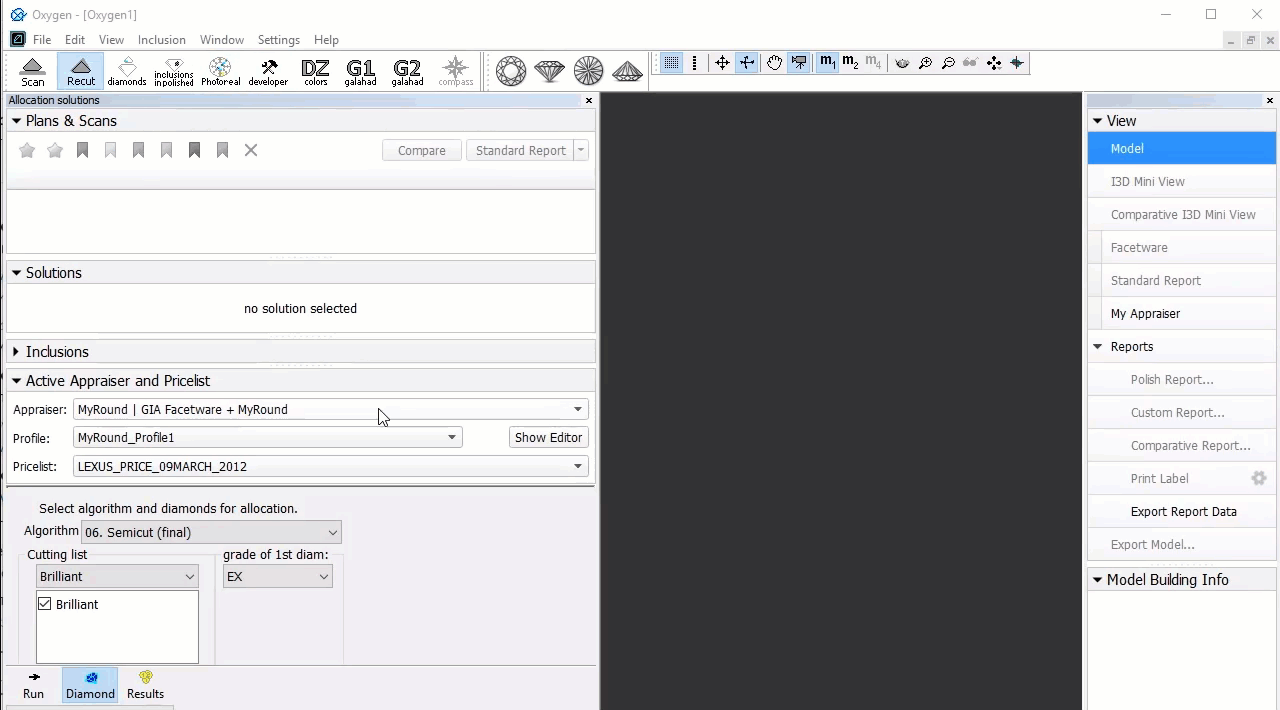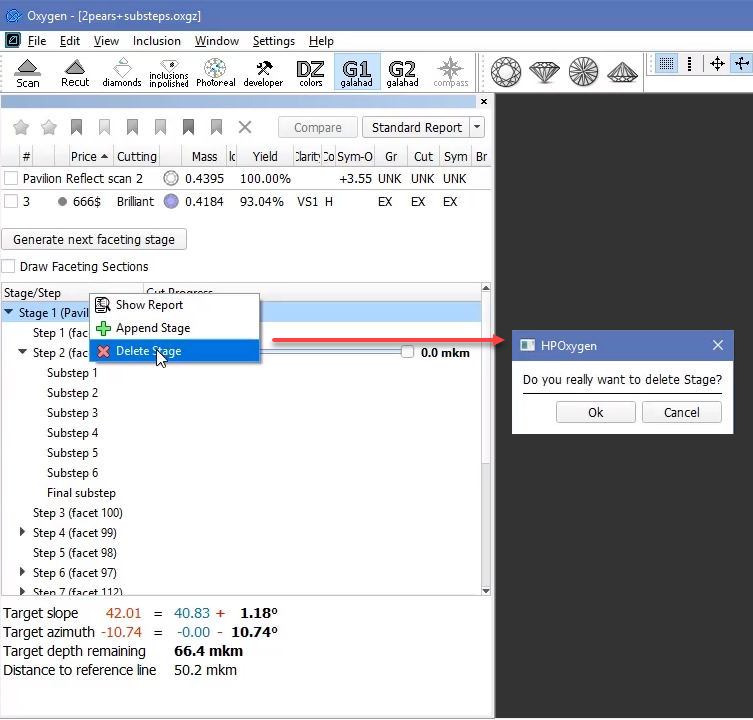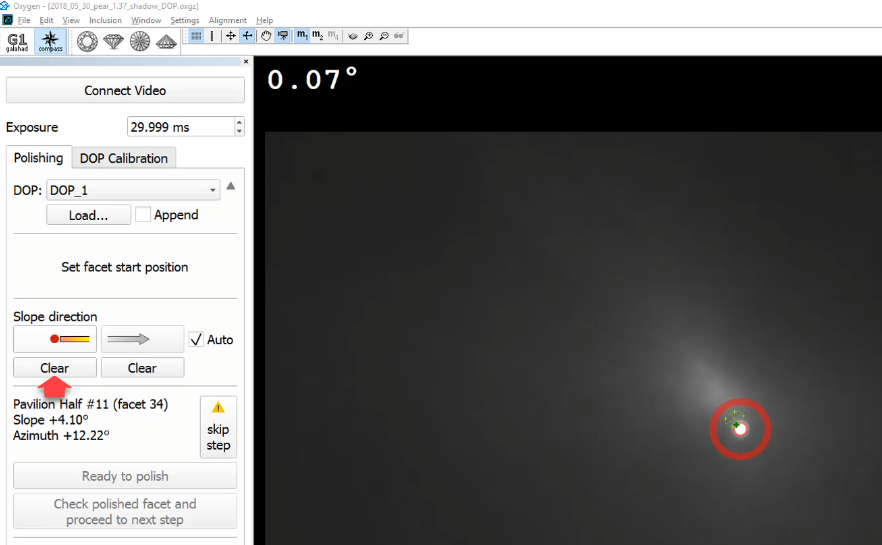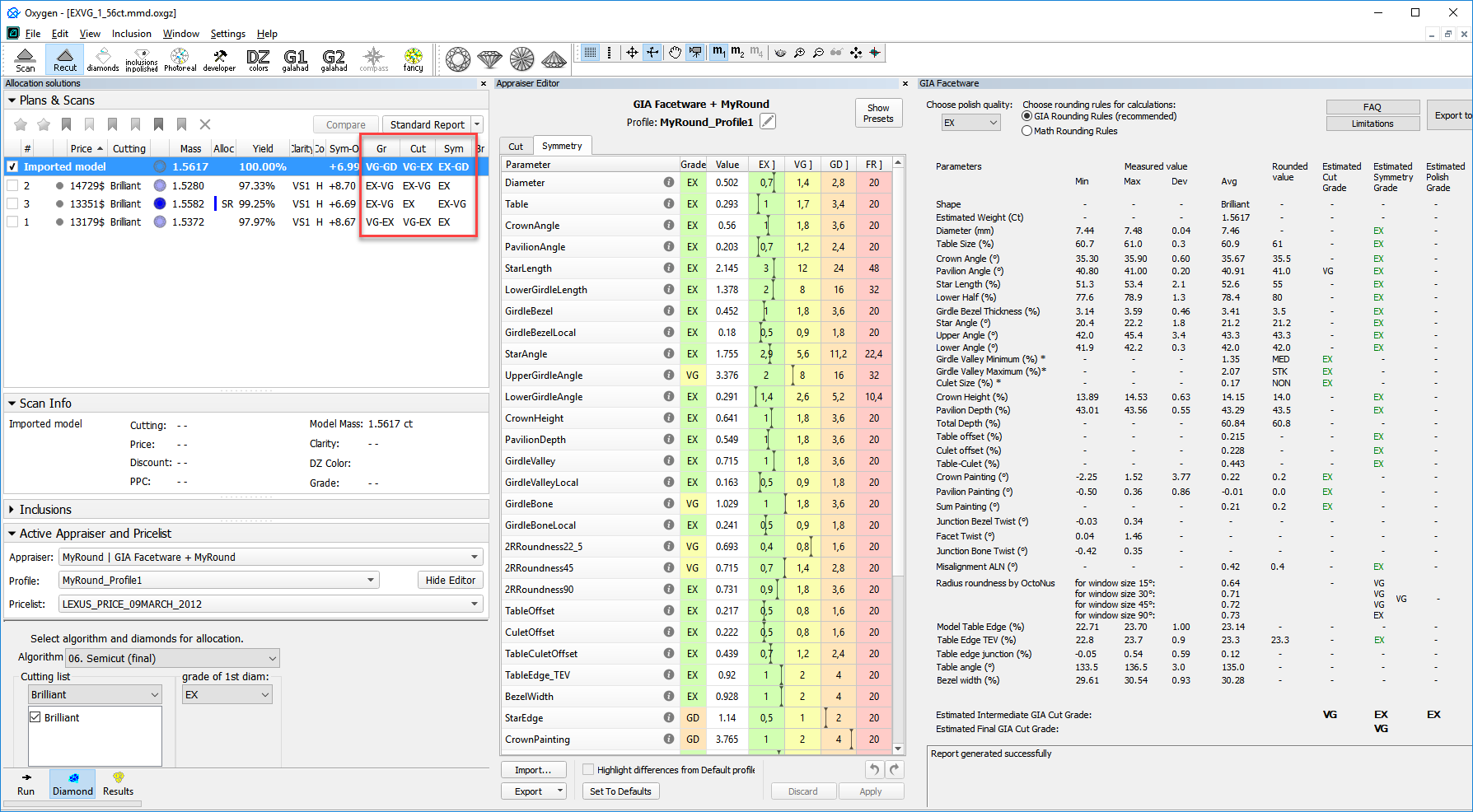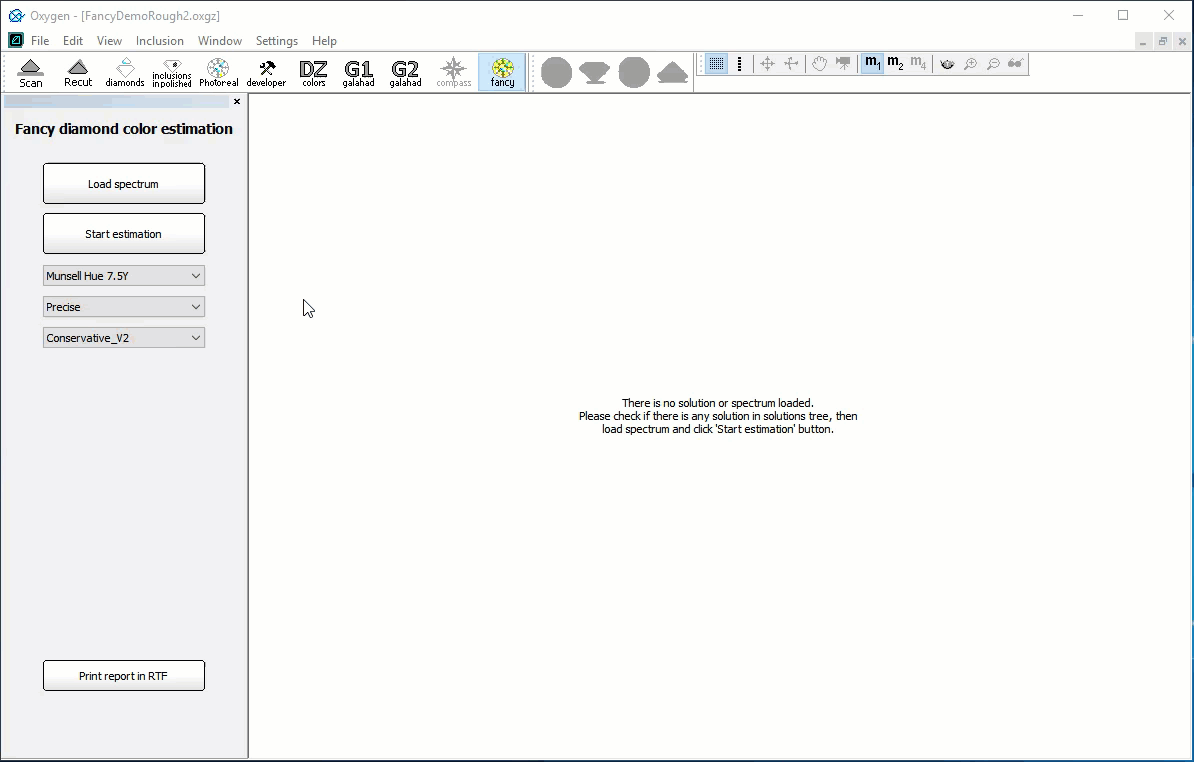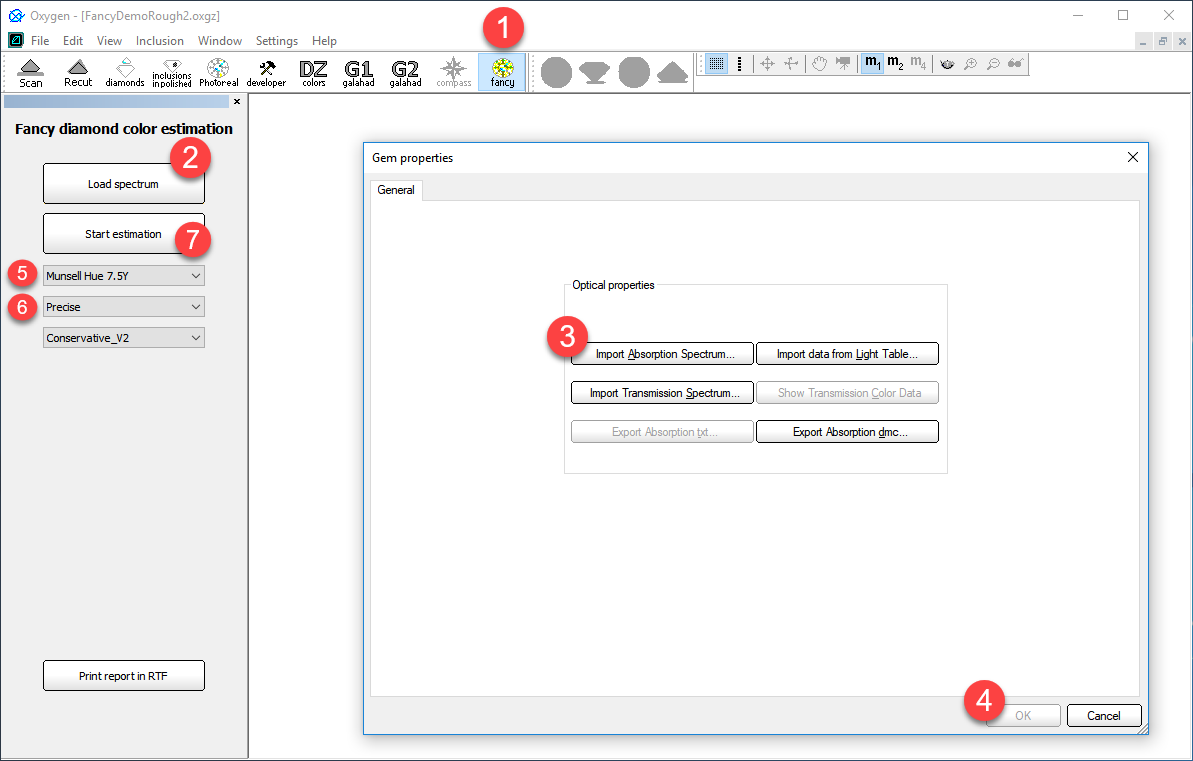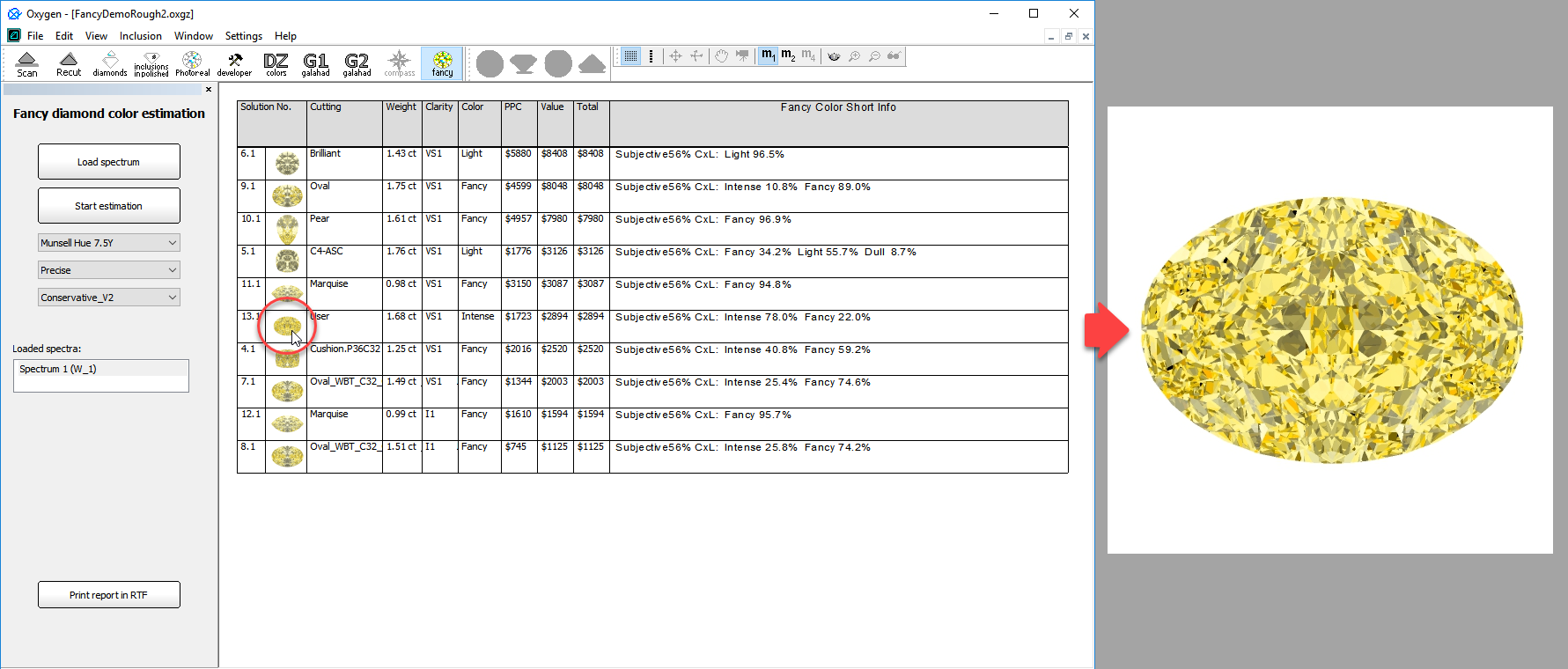...
| Panel | ||||||
|---|---|---|---|---|---|---|
| ||||||
|
Public Features
The functionality described in this section is available to users.
Algorithm "18. Single (Recut)" for Aligning with Blocked Facets
After scanning a blocked diamond, an operator may run the allocation algorithms to check the available polishing options. As in some cases we try to optimize solutions by running the asymmetric Smart Recut allocation, it is better to have a solution which is better aligned with the previously blocked facets. When we run the Smart Recut on such a solution, we may obtain the final solution with a larger mass. The new "18. Single (Recut)" algorithm allows building solutions aligned to the already blocked facets. At least one of the solutions produced by the algorithm is normally aligned to the already blocked facets of a scanned semipolished stone.
| Multimedia | ||||
|---|---|---|---|---|
|
Galahad Mode - Manual Selection of Initial Facet
In Galahad Mode, for the selected step it is now possible to manually select the initial facet different from the one automatically calculated by the system. Once manually set, the initial facet can then at any moment be reset to the default one.
G1 Galahad - Reference Line and Safe Line
In G1 Galahad mode, the reference line is now calculated only once for the entire polishing process (previously it was calculated for each stage separately). Also, the safe line is calculated which is the limit of safe polishing, i.e. each big facet, with the correct facet angles, can be safely polished down to the safe line without risk of damaging the future brilliant. For the crown, the reference line is displayed by a bold orange line, safe line - by a thin dotted orange line. On the left panel, on mouse over the Distance to reference line parameter, the tooltip is displayed with the information about reference and safe lines.
For the pavilion, the reference line is displayed by a bold blue line, safe line - by a thin dotted blue line. The tooltip with the detailed information is also available.
Information about reference and safe lines is also presented in the Faceting Report.
...
| Note |
|---|
Note that if the "Girdle" or "Table" stages are included in the process, the distance to the reference line is recalculated for all other stages. |
Rough Export
The new "Rough Export" feature is added. This allows exporting a rough model (in most cases this will be semipolished stones) along with the set of solutions created for it. You can select one of two options:
- Rough Export - all solutions - the main scan and all the solutions will be exported
- Rough Export - active solution - the main scan and the selected solution will be exported
Recut - Deleting Inclusions
Now you can delete existing inclusions. To delete the inclusion, on the left panel, in the Plans & Scans mode, in the Inclusions section, right-click the inclusion you want to delete, from the context menu, select Delete Inclusion.
...
You can delete several inclusions at once. To do so, select inclusions clicking their names holding the CTRL or SHIFT keys, then use the context or pop-up menu.
Appraiser List Favorites
In the list of appraisers, now you can mark some appraisers as favorites: these marked appraisers will be shown as a "short list" displayed by default. The full list is available on clicking show all. To mark the appraiser as a favorite, click the star mark - it becomes highlighted. To remove the appraiser from favorites, click the start again to deselect .
Custom Coloring Improvement
The colors for the Facet Marking of the Custom Report have been changed. The overview of the updated coloring is presented in the video.
| Multimedia | ||||
|---|---|---|---|---|
|
G1 Panel Improvements
On the Galahad 1 (G1) panel, in all context menus now the icons are displayed which makes working with menus more convenient.
...
When trying to delete the stage, now the confirmation dialog is displayed. There you can confirm deletion of the stage or cancel deletion if you initiated it by mistake.
Support of Scanning without Synchronization Cable
Now the scanning without synchronization cable is supported. On start, the system checks the synchronization cable availability. If a cable present, the scanning uses synchronization. If the cable is not found, scanning still continues - without synchronization.
| Info |
|---|
Note that scanning without synchronization is slower. It is recommended to update the hardware to the newer version (HP_SMC board). |
Galahad Compass - Big Step, Using Same Direction
In Galahad Compass - if a step is separated into sub-steps ("Bid Step" feature), after the direction and zero is set for the first sub-step, the system will automatically use the same direction for all following sub-steps. Previously, an operator should have defined the direction manually for each sub-step. Note that if you need to change the direction manually, you still have the ability to do that: use the Clear button and then set the new direction in a usual way.
New Report Parameters for Cuttings: Emerald, Princess, Heart, Oval, Pear
New parameters for the report were added for different cuttings.
...
| Expand | ||||||||||||||||||||||||||||||||||||||||||||||||||||||||||||||||||||||||||||||||||||||||||||||||||||||||||||||||||||||||||||||||||||
|---|---|---|---|---|---|---|---|---|---|---|---|---|---|---|---|---|---|---|---|---|---|---|---|---|---|---|---|---|---|---|---|---|---|---|---|---|---|---|---|---|---|---|---|---|---|---|---|---|---|---|---|---|---|---|---|---|---|---|---|---|---|---|---|---|---|---|---|---|---|---|---|---|---|---|---|---|---|---|---|---|---|---|---|---|---|---|---|---|---|---|---|---|---|---|---|---|---|---|---|---|---|---|---|---|---|---|---|---|---|---|---|---|---|---|---|---|---|---|---|---|---|---|---|---|---|---|---|---|---|---|---|---|
| ||||||||||||||||||||||||||||||||||||||||||||||||||||||||||||||||||||||||||||||||||||||||||||||||||||||||||||||||||||||||||||||||||||
|
"MyRound | GIA Facetware + MyRound" Appraiser - Dual Grade Display
Now, for the "MyRound | GIA Facetware + MyRound" appraiser, when GIA Facetware and MyRound grades differ, both grades are displayed in the solution list simultaneously.
| Info |
|---|
Grades are displayed in GIA Facetware-MyRound format, for example, "VG-GD" means that GIA Facetware grade is "VG" and MyRound is "GD". |
Lexus Private Details
The information in this section is for sharing with Lexus only.
Fancy Diamond Color Estimation
| Note |
|---|
This functionality is currently available only under "Developer" HASP key. |
Now for your model and it's generated solutions you can obtain the "Fancy Diamond Color Estimation" report. To do so, having the model with solutions opened, go to Fancy mode, then import the relevant absorption spectrum and specify report parameters:
- By default, estimation is targeted at yellow diamonds ("Munsell Hue 7.5Y"). You can also select "Munsell Hue 5.0R" or "Munsell Hue 5.0B" settings to estimate red or blue diamonds respectively.
Estimation can be performed in two modes. "Precise" mode (the default one) gives exact results, while "Fast" allows getting an approximate estimate in short time.
Expand title Show me...
As parameters are specified, click Start estimation.
As the estimation progresses, the calculation results are added to the report table one by one. The displayed Fancy results are:
- Color is DCColor's Subjective 56% CxL Center mark
- Fancy Color Short Info is DCColor's Subjective 56% CxL Fancy zones percentage
The estimation is done within few minutes. You can click the diamond small picture in the report to obtain the full-size image.
You can export the generated report into the .rtf format.
Comparative Report Feature Free of Charge
The Comparative Report feature is now free of charge for all HASP keys.
Fixed Problems
The following fixes for the known problems have been implemented:
...
Fixed slow model building in with Ximea camera 2.3Mpix.
...
| title | E-mail from Kamal Mistry of August 27, 2018 |
|---|
From: Kamal Mistry <lexus.kam@gmail.com>
Sent: Monday, August 27, 2018 4:08 PM
To: Sergey Sivovolenko <sivovolenko@octonus.com>
Cc: Alexander Filonov <filonov@octonus.com>; Janak <janak@lexus-com.com>; Yaroslav Alexandrov <alexandrov@octonus.com>; Savrasov Sergey <savrasov@octonus.com>
Subject: Re: HPO Pavilion reflect for Vision 2018
Dear Sergey,
We have alignthis scanner for shadow scanning and data for shadow scanning is shared is dropbox folder “HPO-PR_Ximia camera_0.5Lens”.
We are not sure how to do camera Synchronisation with this camera, may be due to this timetakenfor model building in HPO is more “creating stone shift contour” .Please see below image.
Shadow scan is measured correctly in this scanner, tomorrow we will start aligning this scanner for reflect scanning. Please let us know if we have to do camera synchronisationand find camera timing.
Best Regards,
Kamal.
...
In Galahad Compass, fixed inaccuracy in calculating angles for some special cases.
...
